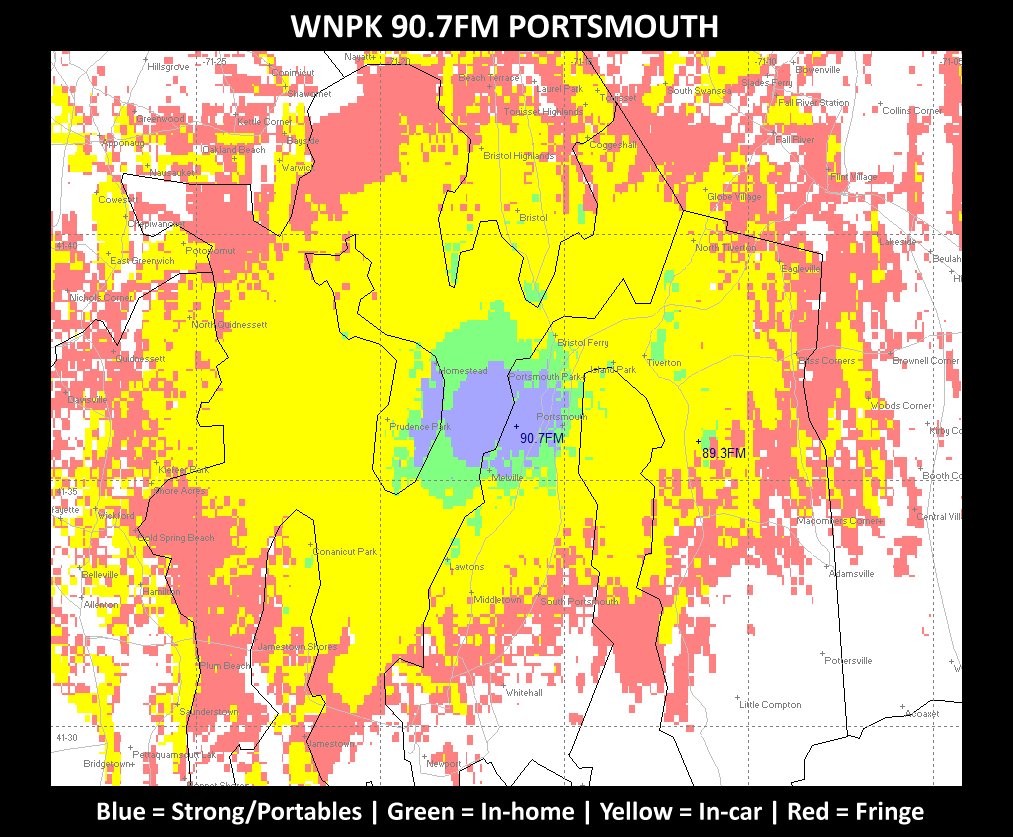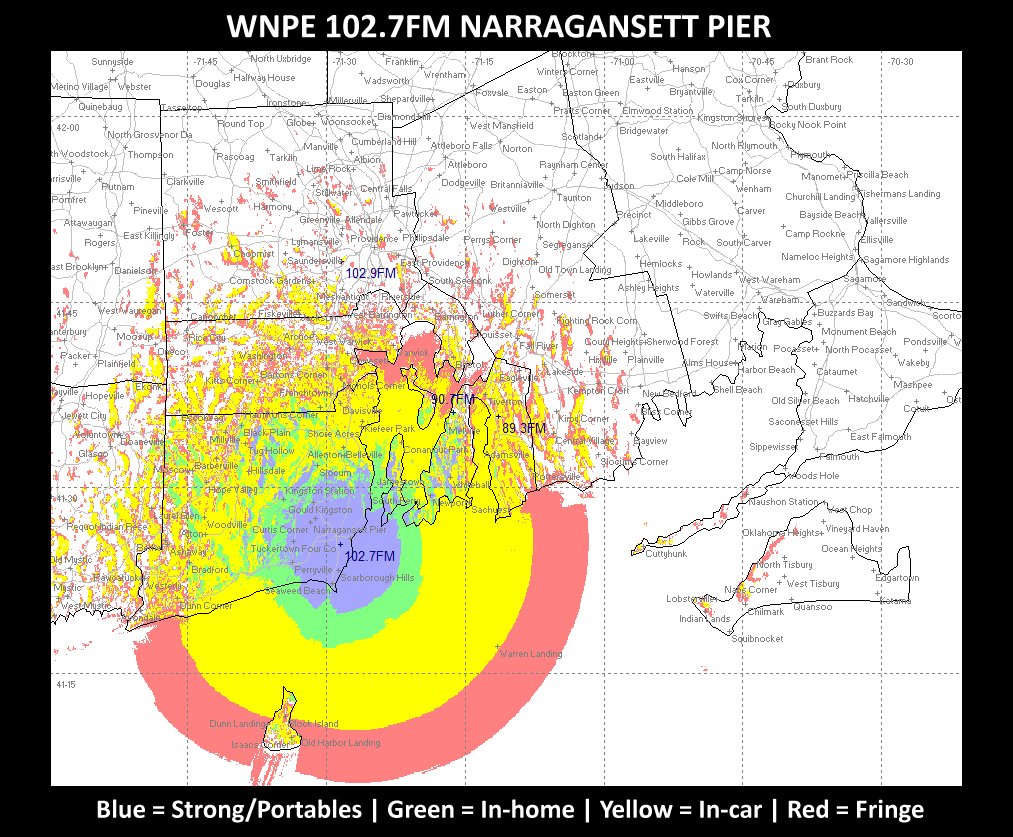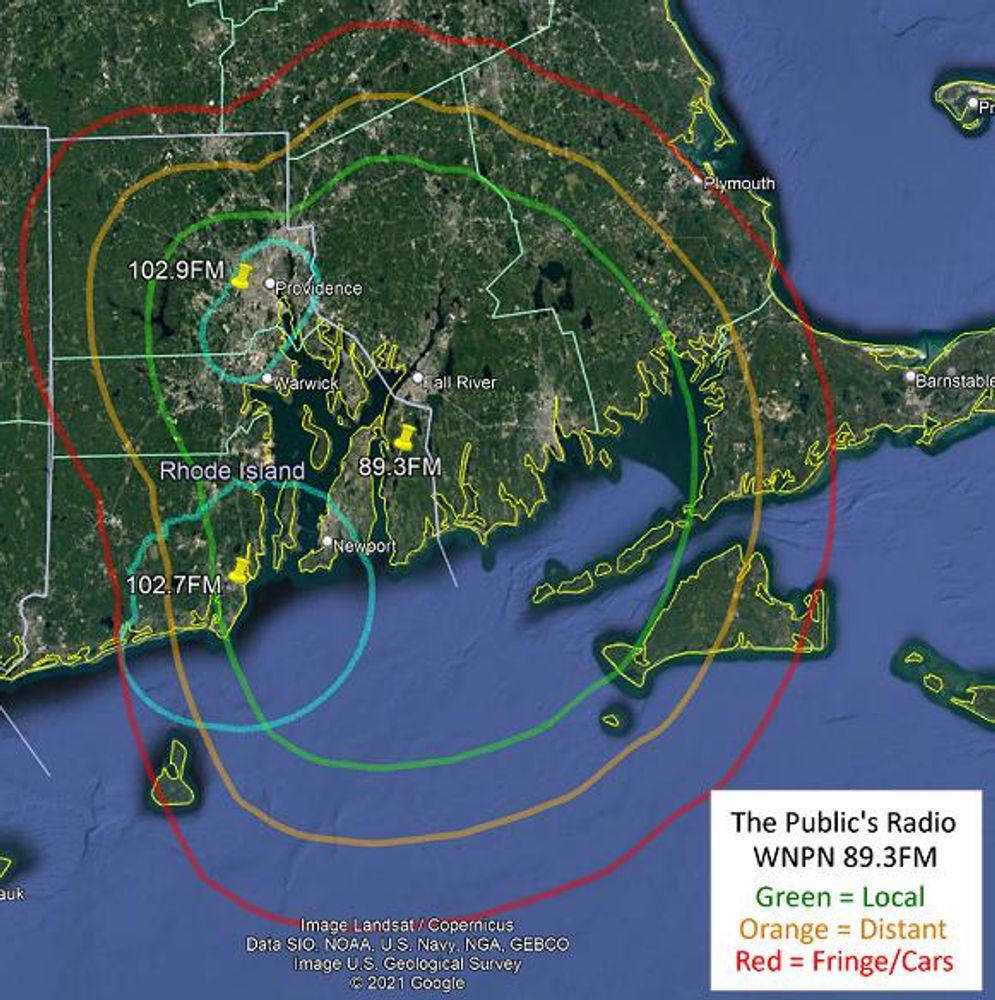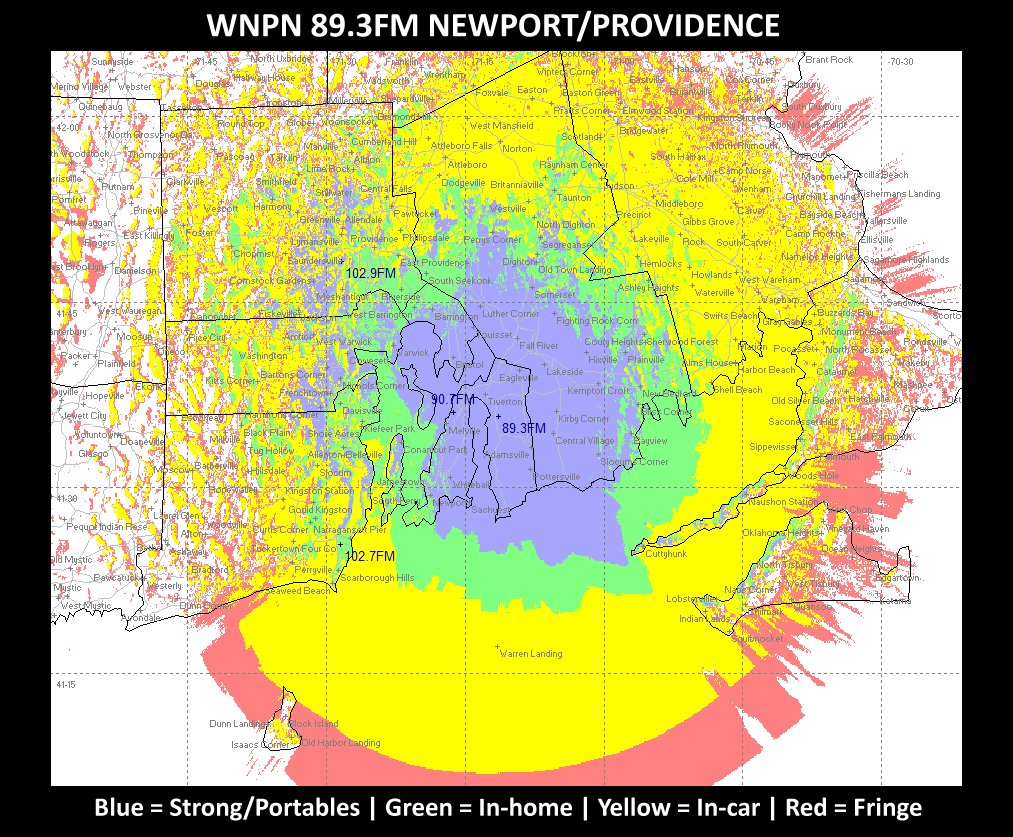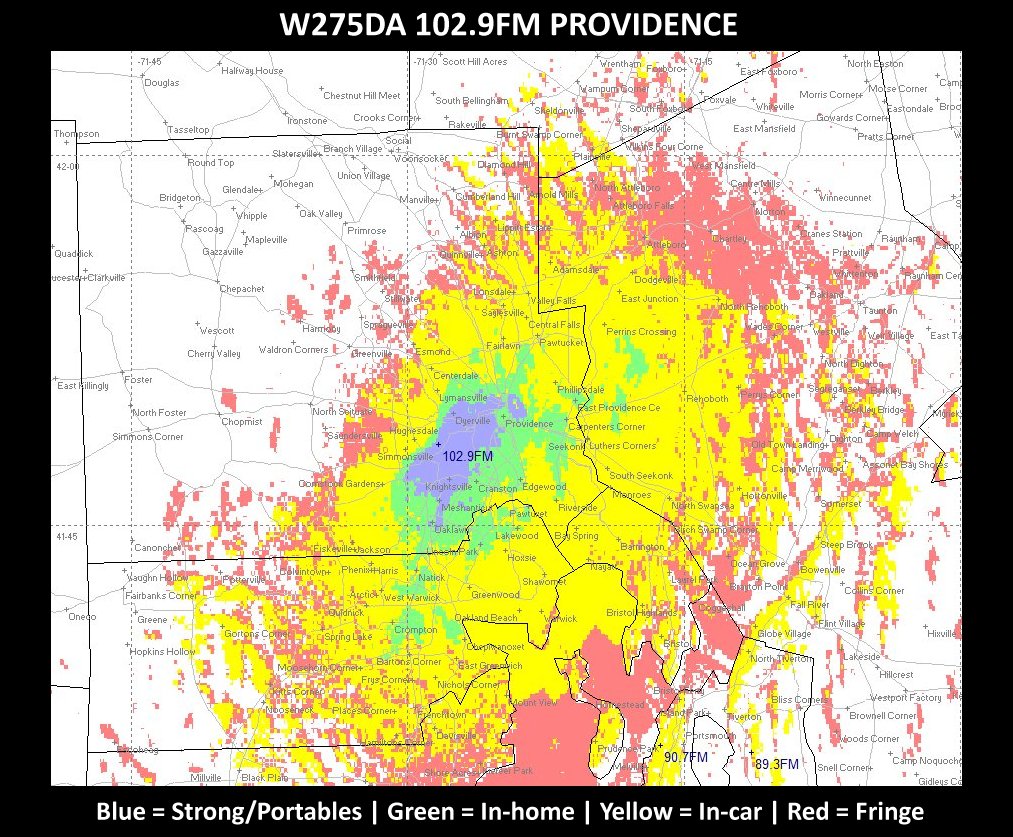The Public's Radio transmits on WNPN 89.3FM across Rhode Island and southeastern Massachusetts.
We also have three "supplemental" signals to augment coverage in specific areas:
- 102.9FM W275DA in Providence. (details here)
- 102.7FM WNPE in South County & Newport.
- 1290AM WPVD in Providence.
- 89.5FM WNPW in Westerly (coming soon!)
- 91.9FM WNPK on Block Island (coming soon!)
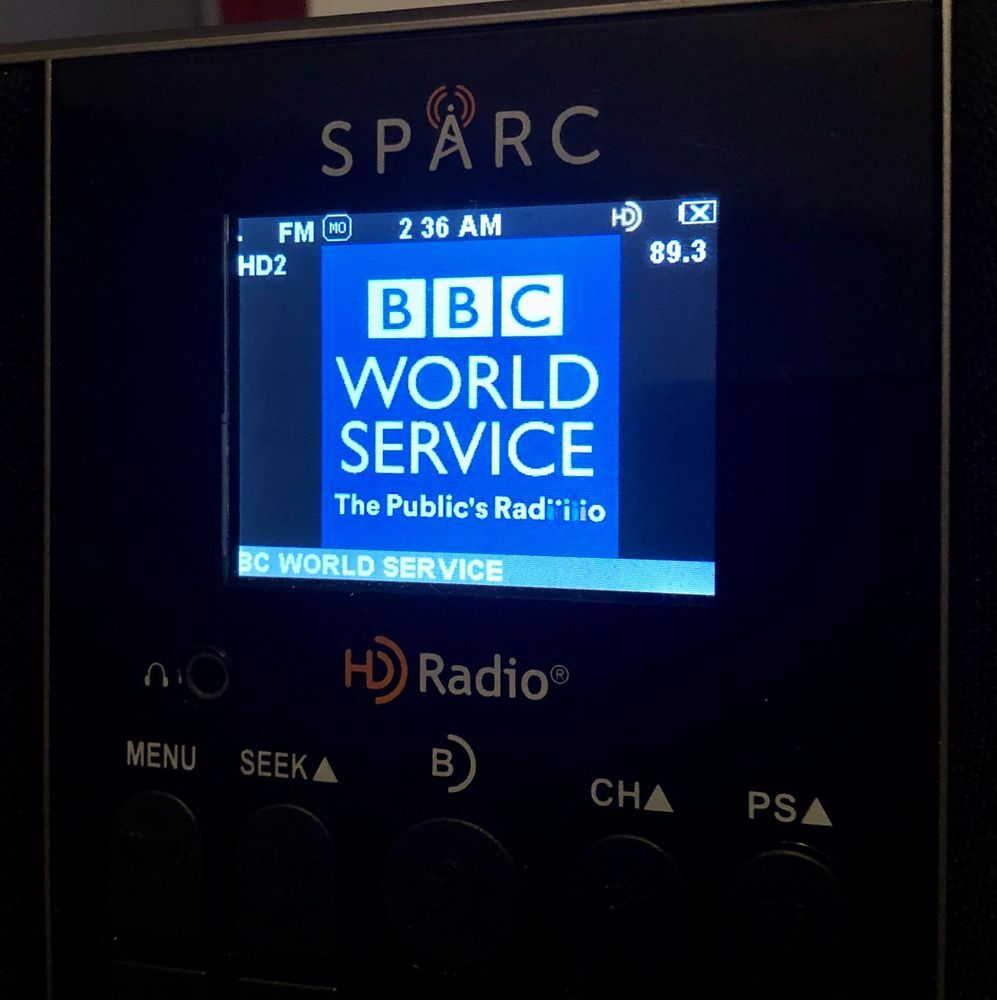
If you have an HD Radio you can tune to 89.3-HD2 for a 24/7 BBC World Service channel.
Also, check out our Real-Time Tech Updates page if you have reception problems.
-------------------
The below map shows the approximate coverage areas of the 89.3FM signal from its tower in Tiverton, RI (shown in green), and the areas of the 102.9FM signal over Providence and 102.7FM over South County & Newport (shown in blue). Also the expected coverage areas of 89.5 over Westerly and 91.9 over Block Island (shown in magenta).
As always, signal maps are an approximation of how far a signal can be heard on a given receiver. Many, many factors influence this, so a contour should be viewed as a starting place for determining reception, not an end point. There are more detailed maps at the bottom of this page.

Note: until September 30, 2021, TPR was also heard on 88.1FM WELH from The Wheeler School (specifically the Wheeler Farm, out in Seekonk).
Note: until April 8, 2021, TPR was also heard on 91.5FM WCVY in Coventry. Our lease with Coventry High School ended and the signal has been made redundant by 89.3FM, so we elected not to renew. More info in The Engineer's Corner.
Note: We also broadcast on WPVD 1290AM Providence but it's a very, very small signal now; just 400 watts daytime only. This is because our listeners made it clear they wanted to hear us on FM, not AM, and it's very expensive to run a 10,000 watt AM station.
Note: We also broadcast on WNPH 90.7FM Portsmouth. As of 2023 it's a very limited signal; we are applying to the FCC to expand it significantly and make it more of a South County/Aquidneck Island signal.
-------------------------------------------
Below are some tips & tricks you can employ to get the best radio listening experience possible. Please note that while we attempt to provide as up-to-date information as possible, and provide as honest opinions as possible, we cannot guarantee that a particular make & model of receiver will automatically work your specific situation. Too many factors, such as location, local terrain, nearby possible sources of interference (even LED lightbulbs or cellphone chargers), and the specific make/model of receiver and antenna will have highly variable impacts on your specific listening experience. That said, we do hope the info provided is helpful for you.
IMPROVE RADIO RECEPTION: BETTER RADIO!
IN-CAR: Most car radios are already pretty good FM receivers, but if your stock radio in your car isn't an HD Radio receiver we recommend getting one, if possible; Crutchfield is helpful here. Both 89.3 and 102.7 transmit in HD, and thus can be heard in clear digital on an HD Radio receiver. But in general HD Radio receivers are just better receivers, period. They have been filtering and better Digital Signal Processing (DSP) so they'll pick up analog FM stations better, too.
IN-HOME: This is also true for in-home radios, although there aren't many HD Radio tabletop receivers available for sale these days; the Insignia NS-HDRAD2 at Best Buy ($50) is one of the only ones you can buy in a store, although others, like Sparc & Sangean models, are available online.
Generally speaking, Tivoli Audio makes pretty good tabletop radios.
PORTABLE: For portable radios, if you can find a portable HD Radio receiver, they're generally good receivers overall. I haven't tried the Sparc SHD-TX2 portable radio, but I have tried the Sparc SHD-BT1 tabletop radio and it's pretty good. Several of the Sangean HD Radios, including the HDR-16, are quite good as well. My current (as of late 2020) "diamond in the rough" find is the Tecsun PL-380, which is $50, fits in a pocket, but boasts an amazingly sensitive tuner for the size of the radio.
IMPROVE RADIO RECEPTION: BETTER ANTENNA!
In general, don't replace your car radio antenna with an aftermarket antenna; most of them (like "Shark fins") sacrifice functionality for aesthetics. Usually the stock antenna is the best bet.
However, replacing your home radio antenna is often a good idea! Many tabletop radios have poor-to-medium stock antennas, but many also allow you to connect an external antenna. Usually through an F connector (commonly called a "co-ax connector" or "cable TV connector") or through a pair of screw terminals and a "balun".
Do you have an old TV antenna on your roof? These are often VHF antennas and will work very well for FM as well. Rotate the antenna towards your preferred signal (use the handy site www.FMfool.com to find the direction/azimuth for your location) and connect the antenna to your radio's "external antenna" jack. Remember to connect the appropriate grounding wires for lightning protection.
Want to buy one of these outdoor TV/VHF antennas? You can find them at local electronics stores like:
- A&J Distributor (no walk-in service, North Kingston, RI / 401-421-0991)
- You-Do-It Electronics (40 Franklin St, Needham, MA / 781-449-1005)
- Some Best Buys will have them, but many don't.
- Some Home Depots will have them, especially ChannelMaster and Winegard.
Ask for a "yagi" (YAH-gee) FM or VHF antenna. Don't get an antenna that's specifically for UHF - those are only for TV and are more common since the DTV migration of 2009. If you're not sure, look for it to say "VHF." It can say it's a TV antenna, too, the key is that it's made for "VHF". If says "VHF", you should be good. And the bigger the better: the larger the antenna, the higher the gain, the more directional it is. That means more of the signal you want and less of the signal you don't, although it also means you have to aim the antenna more carefully, too.
FM only antennas are getting increasingly difficult to find online, but as of August 2022, Newark has the Stellar Labs 30-2460 four-element yagi antenna for sale again.
Engineer's Tip: DIPLEXING! Got a DirecTV or Dish Network satellite dish, and want to add an FM antenna but don't want to run a second, unsightly coaxial cable? You can "diplex" the satellite TV signal and an FM antenna signal on the same coaxial cable. You'll need a pair of diplexers (these are one example), one at either end of the cable - they're usually pretty cheap, well under $20ea, often under $10.
Does your radio seem to have no antenna? That usually means the antenna is the headphone cord (most portables) or the power cord (many clock radios). Adjust either cord to see if it improves reception. If the cord is balled up and shoved behind a table or countertop, that will negatively impact reception.
If an outdoor antenna is impractical, even a simple indoor "di-pole" (DIE-pole) antenna is better than nothing. It's two pieces of wire shaped like a "T", available at Amazon and elsewhere; I've seen them at some hardware stores but it's inconsistently stocked. Mount the antenna with the upper part of the "T" is horizontal and is as "broadside" (perpendicular) as possible to the transmitter you're trying to receive.
-------------------------------------------
DETAILED SIGNAL MAPS
Below are more details maps for each of our signals. Due to the incredible complexity of factors that combine to make up "signal reception", there is no actual perfect map for signals. But these are a good place to start, especially to determine which signal is going to be your best bet to tune us in.
The color-coding is as follows:
- BLUE = very strong signal, suitable for poor receivers like clock radios and most portable tuners.
- GREEN = moderately strong signal, suitable for most listening on decent tabletop and other indoor radios.
- YELLOW = normal signal, suitable for listening on most car radios.
- RED = fringe reception, if you have a very good radio and/or antenna, you might get us out this far.









